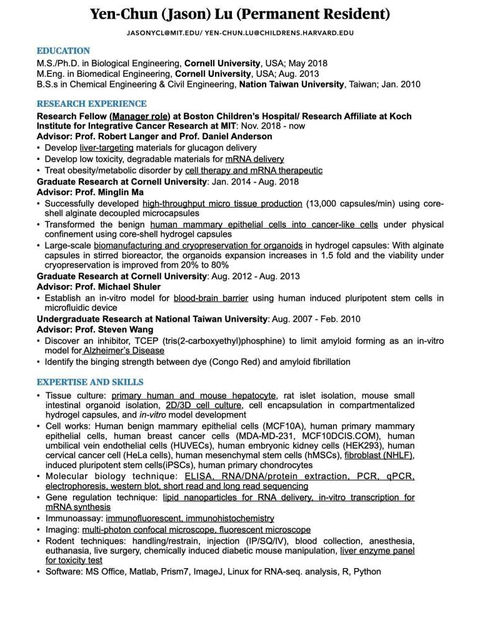How to Write a Resume That Gets You Hired | Job Application Meme(2)
- Jason Lu

- Mar 14, 2023
- 4 min read
Updated: Oct 19

How to Prepare an Effective Resume That Gets You Interview Invitations
A resume is the most important document when it comes to finding a job.
Previously, I shared about the Curriculum Vitae (CV) required for school applications. But what exactly are the differences between a resume and a CV? And how can we prepare an attractive resume that increases our chances of getting an interview invitation from hiring managers?
In this article, I’ll walk you through what a resume is, how it differs from a CV, and share practical tips for crafting a strong and effective resume. Hope you will learn how to write a resume after reading this blog.
What Is a Resume?
A resume is a concise document that summarizes a person’s background on one or two pages. It typically includes your education, work experience, skills, and achievements.
The main purpose of a resume is to provide a clear and focused overview of your qualifications, allowing employers to quickly understand your strengths and determine whether you’re a good fit for the position.
A well-crafted resume helps you stand out among hundreds of applicants and increase your chances of being selected for an interview.
Resume vs. Curriculum Vitae (CV)
A resume is a short, targeted summary of your professional experience, education, and skills—usually one page for recent graduates or up to two pages for experienced professionals.
It’s tailored to a specific job or industry, highlighting the most relevant qualifications for that role. The goal is to communicate your strengths clearly and efficiently to potential employers.
In contrast, a Curriculum Vitae (CV) is a comprehensive record of your entire academic and professional history. It includes detailed information about your education, research, publications, presentations, and other achievements.
A CV is commonly used in academic, research, or medical fields where a complete record of one’s career is required. Unlike a resume, a CV can be several pages long and does not necessarily need to be customized for each job.
In short:
A resume is concise, job-focused, and highlights relevant experience.
A CV is detailed, comprehensive, and suited for academic or research settings.
Tips for Preparing a Strong Resume
How to write a resume?
Preparing a good resume can significantly increase your chances of being shortlisted for interviews. Here are some practical tips to make your resume stand out:
1. Start with a Clear Summary
Begin with a short professional summary (2–3 sentences) that highlights your most relevant skills and experiences.
This section should immediately capture the employer’s attention and give them a quick snapshot of what you bring to the table.
2. Use Bullet Points Effectively
Break up large text blocks with concise bullet points.
Start each bullet with an action verb (e.g., “led,” “developed,” “analyzed”) and quantify your achievements whenever possible to demonstrate impact.
3. Tailor Your Resume to Each Job
Read the job description carefully and customize your resume to match it.
Highlight experiences and skills that are directly relevant to the position. A generic resume is less likely to stand out.
4. Use a Professional Format
Choose a clean, easy-to-read layout with consistent spacing and formatting.
Avoid flashy designs or excessive colors—clarity and readability are key.
5. Focus on Relevant Experience
List your work experience in reverse chronological order, starting with your most recent position. Emphasize responsibilities and achievements that are most relevant to the job you’re applying for.
6. Include Education and Certifications
Provide details of your academic background and any relevant certifications.
Include the institution name, degree or certification earned, and your graduation date.
7. Add Keywords Strategically
Many companies use Applicant Tracking Systems (ATS) to screen resumes automatically.
Include relevant keywords from the job description to help your resume pass initial screenings.
8. Proofread Carefully
Always check for grammar, spelling, and formatting errors.
Ask a trusted friend or mentor to review your resume—you’d be surprised how easy it is to miss small mistakes.
Example
Here’s an example from my own experience:

I started my resume with my educational background, highlighting the universities I attended in bold font to make them easily visible.
Next, I listed my research experiences, emphasizing relevant skills and achievements by quantifying the results. For instance:
“Large-scale biomanufacturing and cryopreservation for organoids in hydrogel capsules: Using alginate capsules in a stirred bioreactor, organoid expansion increased by 1.5-fold, and cryopreservation viability improved from 20% to 80%.”
This sentence effectively demonstrates the impact of the work by providing specific metrics that show progress and contribution to the field.
If you’re a permanent resident, consider noting “Permanent Resident” next to your name—it can sometimes improve your chances of being shortlisted.
Conclusion
A resume is your personal marketing document—and often your first impression with employers. A well-prepared resume helps you stand out from the competition, but creating one takes time and effort.
After proofreading it yourself, seek feedback from friends, mentors, or even professional resume reviewers.
Remember: your resume is just a template—it should be adapted for each job application. Only by tailoring your resume to the job requirements can you truly shine and earn the interview opportunity you deserve.
In future articles, I’ll share more about interview strategies and other job application tips.
Wishing everyone success in finding their dream job!
💼 Further Reading | Build a Smarter Job-Hunting Strategy
Want to learn how to write an impressive resume, ace interviews, and stay ahead in the AI-driven job market?
In my new book, Hacking the Hunt: The Strategic Playbook for Landing Your Dream Job, I share practical frameworks and real-world examples to help you take control of your career journey.
📘 Free Sample Chapter:
Or visit the LuTra Studio publishing page:
Related Article:





Comments